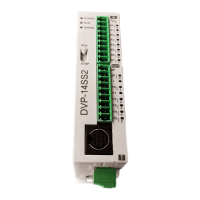DVP-ES2/EX2/EC5/SS2/SA2/SX2/SE&TP Operation Manual - Programming
-222
API
Mnemonic Operands Function
316
YOUT
S
1
, S
2,
S
3,
D
of multiple work
Type
OP
Bit Devices Word devices Program Steps
X Y M S K H KnX
KnY
KnM
KnS
T C D E F
YOUT: 9 steps
ES2/EX2 SS2
SE
ES2/EX2
SS2
SE
ES2/EX2
SS2
SE
Operands:
S
1
:
High-speed counter number
S
2
:
Setting for the number for work stations and
S
3
:
First corresponding device for the comparison
result in the stack area
D
:
First corresponding device for the output work
station
Explanation
1. S
1
is for the setting of the high-speed counter. Use the same settings for the high-speed
counter as for the high-speed counter for the XCMP (API 315) instruction.
2. S
2
occupies two consecutive 16-bit devices. S
2
+0 is n (the work station number) and S
2
+1 is m
(the maximum number of objects). The range for n and m is between 1–32. When the value is
out of range, the value used is the maximum (32) or the minimum (1). The settings for the
operands should be the same as for the XCMP instruction.
3. S
3
is first corresponding device for the comparison result in the stack area. S
3
occupies 2xn
consecutive 16-bit devices and 2xmxn consecutive 32-bit devices (or 4xmxn consecutive
16-bit devices). For information on the functions of each device and the corresponding number
for D, refer to the XCMP instruction (API 315). It is suggested that you use the same variable
as you use for the XCMP instruction.
4. There is no limit on the number of times you can execute the instruction but only one execution
can be done at a time.
5. It is suggested that you use with the XCMP instruction (API 315), and use the same first
corresponding device for the comparison result in the stack area (S
3
).
6. D is only for the outputs of Y and M devices; Y and M should be the BOOL data type. It
occupies a consecutive number of work stations Xn. When used as the output point of Y or the
M device, the instruction refreshes the output states.

